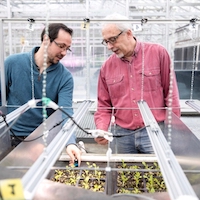One of the steepest barriers to profitable controlled-environment agriculture is the energy cost associated with providing the plants enough light, but new research being pioneered by University of Georgia could cut those costs by 50 percent.
With the support of a $5 million grant, a UGA-led team is working to develop strategies to increase the efficiency of lighting for controlled-environment agriculture: the practice of growing plants in greenhouses or plant factories.
Professor Marc van Iersel, of the UGA College of Agricultural and Environmental Sciences (CAES) Department of Horticulture, is leading the effort. The U.S. Department of Agriculture National Institute for Food and Agriculture Specialty Crop Research Initiative funded the project, called “LAMP: Lighting Approaches to Maximize Profits,” earlier this summer.
“When you are talking about a greenhouse or plant factory, up to 60 percent of their total costs can go to energy and about half of that goes to lighting,” said van Iersel, who has studied ways to reduce the lighting and irrigation costs in greenhouses for more than a decade. “So, if we can reduce those lighting costs, that would be a really big deal. The economic feasibility of plant factories is still questionable because it is so expensive to provide electric light to the plants.”
Currently, high costs and energy usage make it difficult for all but the most valuable crops to be grown profitably in controlled environments. Reducing the costs and carbon footprint of controlled-environment agriculture could open the door to more food being grown in arid, frigid or urban areas or for ornamental plants to be grown more efficiently.
U.S. growers spend about $600 million per year on electricity for lighting in their greenhouses and plant factories. Using informatics, engineering, high-efficiency LED lights and state-of-the-art greenhouse management practices, van Iersel hopes that they will be able to reduce the lighting energy costs by 50 percent.
“This will increase the narrow profit margins in the industry while reducing carbon dioxide emissions associated with energy production,” he said.
The team received the grant funds late this summer and has started work on its prototype lighting systems and strategies to optimize crop growth and quality.
“Having team members with such different areas of expertise is critical to the success of the project,” van Iersel said. “Together, we will be able to do things that none of us can do by ourselves.”
Informatics will be used to schedule lighting around peak power-use times, reduce light use to compensate for natural sunlight and further refine lighting efficiency. Horticulture researchers and engineers will look at the possibility of growing plants with limited-spectrum lighting, which could reduce energy use and be used to manipulate crop growth and quality.
“We want to help producers answer a few simple questions,” van Iersel said. “One: Is lighting cost-effective in their specific situation? Two: If lighting is cost-effective, are high-pressure sodium or LED lamps the better option? And three: What is the most cost-effective way to use those lamps?”
They’ll also be calculating the carbon footprint of each scenario to see if growing indoors makes environmental sense.
Answering these questions could help growers decide when it may be feasible to grow crops in a harsh environment and when it makes better sense to ship food to a location. Their findings could also have substantial impact on the way military deployments provide fresh food to troops or how fresh produce is supplied to desert or arctic locales.
CAES team members dedicated to the project include van Iersel, horticulture professor Paul Thomas, agricultural economist Ben Campbell and impact evaluation expert Kay Kelsey.
UGA faculty Mark Haidekker, WenZhan Song, Javad Mohammadpour Velni and Tom Lawrence, all of the College of Engineering, will contribute to the project, as will UGA Terry College of Business energy informatics experts Rick Watson and Maric Boudreau.
Collaborators from other institutions include Jennifer Boldt at the USDA Agricultural Research Service in Toledo, Ohio; Neil Mattson and Kale Harbick at Cornell University; A.J. Both at Rutgers University; Bruce Bugbee at Utah State University; and Tessa Pocock at the Rensselaer Polytechnic Institute.
For more information about the project, visit http://www.facebook.com/HortLAMP/.








